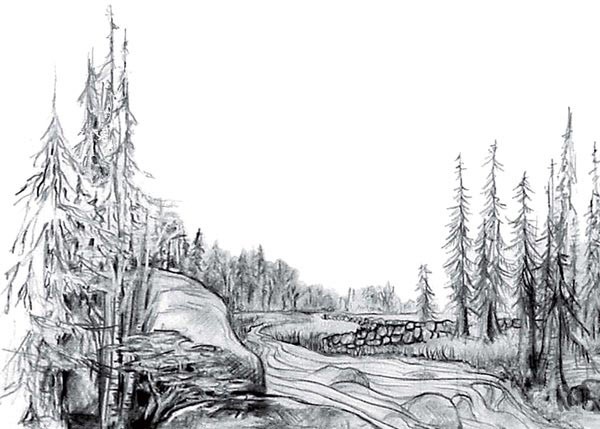I’ve always been grateful that, in the great melding and merging of tongues that produced our beloved English language, we came out of it all with “tree” as the word we use for a tree. Tree is a light, airy word altogether fitting for those magnificent plants that rise up into the sky to be dappled by the sun and ruffled by the wind. It rhymes with “glee” and “free” and “see” and “be.”
What would Joyce Kilmer ever have written if the Greek word for tree rather than the Middle English one had emerged triumphant in the process of natural linguistic selection? He never could have penned those thumping iambic tetrameter lines that etch themselves so indelibly into memory that we can’t rid ourselves of them even if we want to:
I think that I shall never see
A poem lovely as a tree.
He would have had to make do with some messy, imperfect rhyme instead:
I think that I shall never send on
A letter lovely as a dendron.
“Dendron” has ominous alliterative associations: dengue, dungeon, doom, dead. Dendrons, by the sound of them, ought to be citizens of an evil nation in a science-fiction saga, allies of the Klingons in Star Trek.
The aversion I feel to this word may explain my reluctance to take up the study of dendrology but in no way excuses it. Indeed, all this self-erected obstacle has done is expand the range of my already formidable ignorance. I take some pride in knowing by name most of the trees in my home territory, but beyond that I know next to nothing about them. And what little I do know is impressionistic stuff, miles wide of hard science. I know, for instance, that no matter how grand and dramatic the brilliant foliage of fall may be, the pastel waves of greening poplars and the blush of red-maple buds washing over the hills in spring make the far sweeter sight.
Along with that panoramic feast for the eye come the little close-up miracles that transpire on branchlet and twig. Rita and I take the same walk each morning to follow day by day the slow-motion emergence of leaf and flower, a process as touching to the heart and dazzling to the mind as the birth of a lamb, the pipping of a chick. If the child is father to the man, then each tiny leaf of red oak and white ash, even in its first unfolding, is the clearly recognizable parent of the oak’s bristly adult leaf, of the pinnate ash frond to come. Infant red maple leaves, bronzy and iridescent, are as tightly clenched as a baby’s fist. Open them up and, just like a baby’s hand, they will curl softly back around your fingers. Beech leaves swell out of their slender, lanceolate buds and leave wispy husks behind like shed snakeskins.
Our shadbush flowered on May 3 last spring, a week or so earlier than it usually does, and ushered in a bonanza of tree florescence. A roadside white ash sprouted a cloud of reddish cheerleader pompoms – male flowers, I think (staminate, that is). At any rate, stunning. A white birch was so heavily festooned with catkins it looked like a benign arboreal Medusa, adrip with tiny red-spotted yellow snakes.
And the sugar maples. They practically disappeared in their own deluge of yellow flowers. Yellow pollen, yellow flowers everywhere: in the driveway, in the rivers and streams. I quit fishing one afternoon because I had to clean my line and fly after practically every cast. The flowers clogged the hook and formed a yellow gob around the surgeon’s knot in the leader. I’ve never witnessed a flowering quite like it. Or maybe I just haven’t been paying careful enough attention in the past. Maybe several maple flowerings every bit as wondrous as this one have gone by me, and I’ve been oblivious. Maybe if I’d been attending to what was in front of my face, I would have seen what was plainly there to see. Folks who have looked and seen noticed long ago that sugar maples in a given area have heavy crops of flowers and fruit one year but then may show no flowers at all for the next two or more years. Then again, there are maverick maples that refuse to go along with the crowd and flower whenever they damn please. I’ve always had a soft spot in my heart for trees and critters and people who go their own way, and I wonder what motivates those individualistic maples.
I’ve just picked up a copy of the old standard dendrology text by professors Harlow and Harrar, also two silvics handbooks put out by the USDA Forest Service. Maybe I’ll learn from them what makes those offbeat maples tick. And if I stick with dendrology long enough, I may eventually even see a dendron lovely as a tree.


